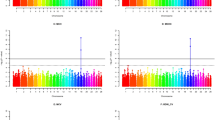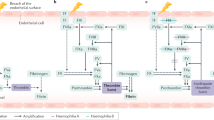Abstract
THREE haemoglobin phenotypes accounted for by the existence of two alleles have been demonstrated in various breeds of sheep1–4. Animals studied have included those homozygous for haemoglobin A (Hb-A) or haemoglobin B (Hb-B) while others were heterozygous for these two haemoglobins. In 1963, a new haemoglobin type was reported in sheep carrying the Hb-A gene after they had been made anaemic by severe bleeding5. A new type of haemoglobin (designated Hb-C) was later reported in sheep with experimental anaemia6. Haemoglobin C completely replaced Hb-A in the severely anaemic animals. No such variant was detectable in sheep homozygous for Hb-B after severe loss of blood. This Hb-C is probably the same as Hb-N described by Brænd et al.7 in a highly anaemic lamb, and occurring rather commonly in Norwegian breeds of sheep8,9. Studies of the chemical structure of the previously mentioned ovine haemoglobins have shown that they differ in the non-alpha chains (Hb-A = αA2βA2, Hb-B = αA2βB2, Hb-C = αA2βC2) (refs. 6, 10–12).
This is a preview of subscription content, access via your institution
Access options
Subscribe to this journal
Receive 51 print issues and online access
$199.00 per year
only $3.90 per issue
Buy this article
- Purchase on Springer Link
- Instant access to full article PDF
Prices may be subject to local taxes which are calculated during checkout
Similar content being viewed by others
References
Harris, H., and Warren, F. L., Biochem. J., 60, 29 (1955).
Cabannes, R., and Serain, C., CR Soc. Biol., 149, 1193 (1955).
Evans, J. V., King, J. W. B., Cohen, B. L., Harris, H., and Warren, F. L., Nature, 178, 849 (1956).
Van der Helm, H. T., van Vliet, G., and Huisman, T. H. J., Arch. Biochem. Biophys., 72, 331 (1957).
Blunt, M. H., and Evans, J. V., Nature, 200, 1215 (1963).
Van Vliet, G., and Huisman, T. H. J., Biochem. J., 93, 401 (1964).
Brænd, M., Efremov, G., and Helle, O., Nature, 204, 700 (1964).
Brænd, M., and Efremov, G., Nature, 205, 186 (1965).
Efremov, G., and Brænd, M., Anim. Prod., 8, 161 (1966).
Muller, C. J., thesis (Van Gorcum and Co., Assen, 1961).
Huisman, T. H. J., Reynolds, C. A., Dozy, A. M., and Wilson, J. B., J. Biol. Chem., 240, 2455 (1965).
Beale, D., Lehmann, H., Drury, A., and Tucker, E. M., Nature, 209, 1099 (1966).
Borun, E. R., Figueroa, W. G., and Perry, S. M., J. Clin. Invest., 36, 676 (1957).
Itano, H. A., and Robinson, E., Nature, 183, 1799 (1959).
Gammack, D. B., Huehns, E. R., Shooter, E. M., and Gerald, P. S., J. Mol. Biol., 2, 372 (1960).
Efremov, G., and Brænd, M., Biochem. J., 97, 867 (1965).
Author information
Authors and Affiliations
Rights and permissions
About this article
Cite this article
VASKOV, B., EFREMOV, G. Fourth Haemoglobin Type in Sheep. Nature 216, 593–594 (1967). https://doi.org/10.1038/216593a0
Received:
Published:
Issue Date:
DOI: https://doi.org/10.1038/216593a0
Comments
By submitting a comment you agree to abide by our Terms and Community Guidelines. If you find something abusive or that does not comply with our terms or guidelines please flag it as inappropriate.



